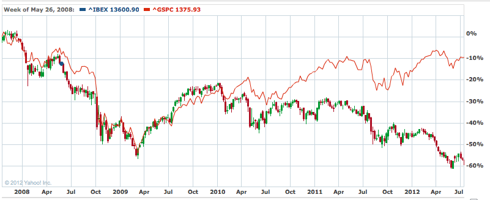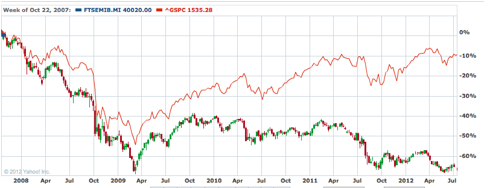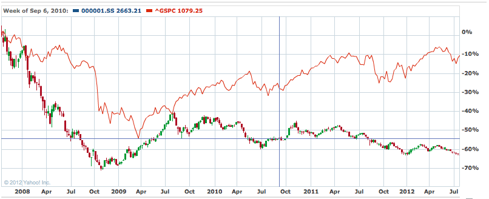 greater crisis than the one in 2008-2009 but you wouldn’t know it by looking at US stock prices. The S&P 500 is down only about 10% from its peak levels in October 2007 compared to the leading indicator stock markets in Spain, Italy and China which…are all down by 60% or more since their peaks. It is folly to think that the S&P 500 index can long withstand simultaneous conflagrations in those countries because, as their economies go, so too will the entire global economy and [that is bound to adversely affect the U.S. as] close to 50% of all S&P 500 earnings are derived from outside the U.S.. Words: 840
greater crisis than the one in 2008-2009 but you wouldn’t know it by looking at US stock prices. The S&P 500 is down only about 10% from its peak levels in October 2007 compared to the leading indicator stock markets in Spain, Italy and China which…are all down by 60% or more since their peaks. It is folly to think that the S&P 500 index can long withstand simultaneous conflagrations in those countries because, as their economies go, so too will the entire global economy and [that is bound to adversely affect the U.S. as] close to 50% of all S&P 500 earnings are derived from outside the U.S.. Words: 840Lorimer Wilson, editor of www.munKNEE.com (Your Key to Making Money!) and www.FinancialArticleSummariesToday.com (A site for sore eyes and inquisitive minds) has edited the article below for length and clarity – see Editor’s Note at the bottom of the page. This paragraph must be included in any article re-posting to avoid copyright infringement.
Kostohryz goes on to say, in part:
Below I provide charts of three equity markets that I consider to be “leading indicators,” in the current global environment: Spain, Italy and China. Spain and Italy…because the entirety of Europe’s economy will ultimately be driven by what happens to Spain and Italy and, by the same token, the fate of Asia’s economies will be determined by what ultimately transpires in China.
IBEX 35 (Madrid) vs S&P 500
FTSE MIB (Milan) vs. S&P 500
SSE (Shanghai) vs. S&P 500
All three of the above charts…show unequivocal signs of serious distress and rapidly deteriorating financial and economic conditions. By contrast, the S&P 500 index is conspicuous for the apparent complacency reflected in its prices. This complacency must be considered rather anomalous given the global nature of the companies that comprise the S&P 500 index….
S&P 500 has Decoupled from Spanish, Italian and Chinese Stock Markets
The most important thing to note is that the S&P 500 has radically decoupled from Spanish, Italian and Chinese markets since mid 2011. Since that time, the S&P 500 has been essentially flat while the three leading markets highlighted have been in the midst of brutal bear markets that show few signs of abating. Furthermore, fundamentally and technically, the three leading markets highlighted appear headed for even lower lows.
Take Note:
It is folly to think that the S&P 500 index can long withstand simultaneous conflagrations in Spain, Italy and China because, as these economies go, so too will the entire global economy. In this regard it is important to understand that close to 50% of all S&P 500 earnings are derived outside the US. Furthermore, the global economic imprint on S&P 500 EPS rises to well over 60% if the impact of globally priced commodities is factored into a sensitivity analysis.
The Reason For The Decoupling
US investors have enjoyed a remarkable decoupling of US stocks from global equity indices. The question is: Why has this occurred?
[While] various reasons could be cited…I think the most important reason is psychological.- A phenomenon has transpired that is akin to “the boy who cried wolf” parable. US investors have “gotten sick” of hearing about the European crisis and a possible hard landing in China. US investors have been constantly bombarded with warnings about these global threats for a year or more yet European economic growth is merely flat (as opposed to collapsing) and Chinese economic growth is tracking at close to 8.0%, which is more than respectable.
- The fact that the crises in Europe and China have not transpired as feared has made US investors complacent. US investors have essentially “lost interest” in developments in foreign lands that they have little or no knowledge/understanding of, supposing that either crises in these regions will not occur, and/or that their own investments will not be seriously affected.
Conclusion
US investor apathy won’t change the course of events in Europe and China. Nor will current complacency prevent the consequences of these crises to ultimately become manifest in US investor portfolios. Whether you are an index investor in ETFs…or an equity investor in stocks with a strong global footprint…it would be foolish to think that the decoupling of US equities from global equities can continue for long.
US stocks have yet to decline because the feared foreign crises have yet to transpire. However, equity indices in the key nations are clearly signaling a high likelihood that such crises will occur. Fundamental economic data emerging from these nations reinforces this view.
Many that are bullish about US equity prospects take heart from such parochial fundamental information as US housing starts. Likewise, bullish chartists take heart from the price action of various domestic US equity indices and/or sub-indices.
I advise, however, that US investors adopt a much more global perspective:
- Regarding fundamentals, given that the S&P 500 is an index comprised of companies that derive their profits primarily from international factors, investors should examine data regarding the economic cycle in key international economies.
- Technical analysts should take a look at the price action of various international equity indices and/or sub-indices for clues about what may soon transpire in the US.
Viewed from the above international perspective, and particularly from the point of view of the three key “leading” economies and financial markets that I highlighted, the prospects for the S&P 500 are not looking good at all.
*http://seekingalpha.com/article/739171-dramatic-decoupling-of-u-s-stocks-from-global-equities-to-end (To access the above article please copy the URL and paste it into your browser.)
Editor’s Note: The above article may have been edited ([ ]), abridged (…), and reformatted (including the title, some sub-titles and bold/italics emphases) for the sake of clarity and brevity to ensure a fast and easy read. The article’s views and conclusions are unaltered and no personal comments have been included to maintain the integrity of the original article.
Related Articles:
1. S&P 500′s Performance Will Determine If, and When, We Have QE3 – Here’s Why
If you are angry about LIBOR – angry that 18 banks can set one of the world’s most important interest rates in such a poorly supervised, ill-understood manner – you should be even angrier that just 12 people sitting in a room can set the world’s single most important interest rate to suit the needs of the stock market, all under the pretence of controlling inflation? Let me explain. Words: 810
2. Black-Scholes “Volatility Smile” Suggests S&P 500 Could End 2012 15% Higher – Here’s Why
According to all sorts of financial media, the end of the fiscal world as we know it is about to occur. All rational individuals surely would come to the same conclusion, right? Wrong! For the past 3 years, the “world has been ending” according to nearly every publication. The market however, simply does not agree with this prognosis. Throughout the past 3 years, despite the negative headlines, the markets have rallied over 50% in wave after wave of briefly interrupted momentum. Given this continuous counter-intuitive bullish onslaught, and according to the volatility smile and the current positioning of money in the options market, I believe it is entirely possible for the S&P 500 to end the year…up 15% from its current price. [Let me explain.] Words: 829
3. Richard Russell: Market Caught in Standstill Between 2 Opposing Forces – Which Will Win Out?
The whole world of fundamental and technical analysis seems to be in a state of chronic confusion – confounded by this seemingly trendless stock market….[Usually] the stock market possesses the ability to forecast coming events but the periodic spates of Fed stimulation have thrown some sand into the stock market’s delicate machine….Thus, we see the stock market ‘up on Fed-created stilts’ and at the same time we see depressing economic news in the newspaper headlines. Meanwhile, Treasury yields are sitting on near-record lows. We’re seeing a strange paradox here.
4. The Bulls vs. the Bears: Which Direction are Stock Prices Going?
We are continuing to see ongoing pessimism among individual investors about the short-term direction of stock prices [but if you are a contrarian you should bet on a continued rise in stocks despite the continued sense of unease. Let’s take a look at a few charts that tell the story.] Words: 510
5. Fitzpatrick: Consumer Confidence Double-Top Suggests Stocks Could Plunge
Looking at the charts we…[see] a very strong double-top formation – very similar to what we saw back in 1980….[which suggests] that we are headed all the way back down again, possibly even to the lows that we saw in 2011….This is likely to weigh on equities. Words: 291
6. What Does the Current “Q Ratio” Say About U.S. Equities?
The Q Ratio is a popular method of estimating the fair value of the stock market developed by Nobel Laureate James Tobin. My latest estimates [suggest] that the broad stock market is about 33% above its arithmetic mean and 42% above its geometric mean……Periods of over- and under-valuation can last for many years at a time, however, so the Q Ratio is not a useful indicator for short-term investment timelines [and, as such,] is more appropriate for formulating expectations for long-term market performance. [Let me review the Q ratio with you, along with several graphs, so you can clearly understand what the Q ratio is, how it works and what it is currently conveying.] Words: 800
7. Goldman Sachs’ Leading Indicators Signal Steep Market Crash Ahead
Goldman Sachs reports their Global Economic Indicators (GLI) show the world has re-entered a contraction and…is predicting a market crash worse than that of the early 90′s recession and one slightly less than the sell-off at the turn of the millennium. [Below are graphs to support their contentions.] Words: 250
8. Marc Faber: We Could Have a Crash Like in 1987 This Fall! Here’s Why
Marc Faber has stated in an interview* on Bloomberg Television that “I think the market will have difficulties to move up strongly unless we have a massive QE3 (something Faber thinks would “definitely occur” if the S&P 500 dropped another 100 to 150 points. If it bounces back to 1,400, he said, the Fed will probably wait to see how the economy develops)….. If the market makes a new high, it will be with very few stocks pushing up and the majority of stocks having already rolled over….If it moves and makes a high above 1,422, the second half of the year could witness a crash, like in 1987.” Words: 708
9. Pento: Markets Will Fall Significantly This Summer – Here’s Why
Investors are being told that the worsening sovereign debt crisis in Europe will leave the U.S. economy unscathed….[because,] since we don’t make many things to export to Europe, our GDP won’t suffer a significant decline at all…. What [has been] conveniently overlooked, [however’] is the fact that 40% of S&P 500 earnings are derived from foreign economies and the seventeen countries that make up the Eurozone have collapsed into recession. [Let me explain what effect that will have on the performance of the S&P 500 this summer.] Words: 325
10. This New ‘Peak Fear’ Indicator Gives You an Investment Edge
We are at a major crossroads in the equity and bond markets. We could see a major ‘risk-on’ rally in the S&P 500 BUT if no equity rally ensues, and U.S. Treasury note yields keep falling, then something terrible is about to strike at the heart of the global capital markets…. [As such, it is imperative that you keep a close eye on this new ‘Peak Price’ indicator. Let me explain.] Words: 450
 munKNEE.com Your Key to Making Money
munKNEE.com Your Key to Making Money










